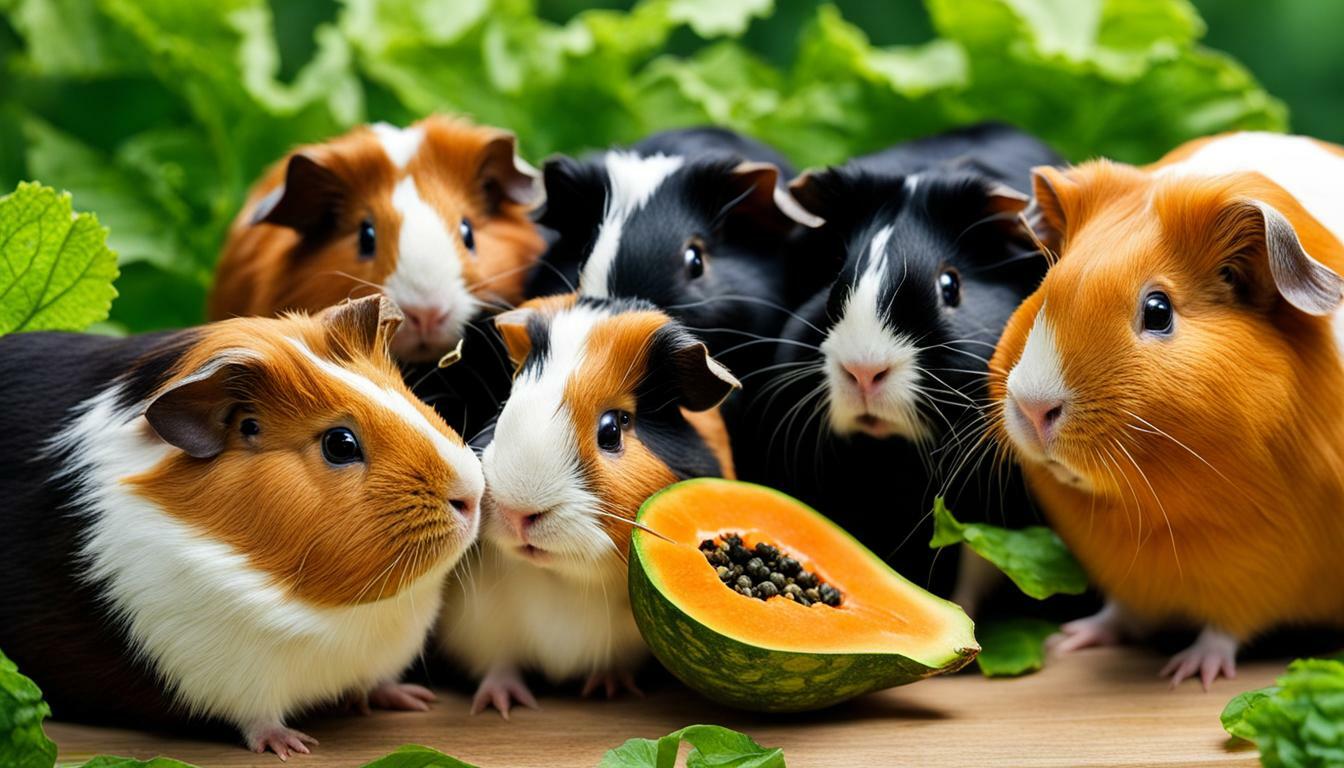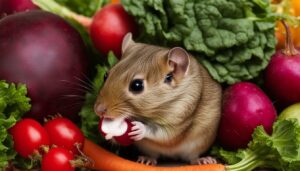If you’re wondering “Can Guinea Pigs Eat Papaya?” you’ve come to the right place to find out. Guinea pigs can indeed enjoy papayas as part of their diet, and it can provide them with essential nutrients. However, there are some important considerations to keep in mind when feeding papaya to your furry friends.
Key Takeaways:
- Papaya is a healthy addition to a guinea pig’s diet, as it is rich in essential nutrients like vitamin C.
- Feed papaya to guinea pigs in moderation due to its high sugar content.
- Remove the seeds from papaya before feeding it to guinea pigs to prevent choking hazards.
- Introduce papaya slowly and monitor guinea pigs for any allergic reactions or adverse effects.
- A few slices or chunks of ripe papaya twice a week is recommended for guinea pigs.
The Health Benefits of Papaya for Guinea Pigs
Feeding your guinea pigs papaya can offer several health benefits. Papaya is packed with essential nutrients that contribute to your furry companions’ overall well-being. One of the key nutrients found in papaya is vitamin C, which is crucial for guinea pigs because they cannot produce it on their own. This vitamin is essential for maintaining a healthy immune system and preventing diseases.
In addition to vitamin C, papaya also contains other important nutrients like fiber, potassium, and antioxidants. The fiber content aids in digestion and promotes a healthy gut, preventing digestive issues. Potassium is vital for maintaining normal heart and muscle function in guinea pigs. Antioxidants help protect their cells from damage caused by free radicals, reducing the risk of certain diseases.
When introducing papaya to your guinea pigs’ diet, it’s important to do so gradually and in moderation. While papaya offers numerous health benefits, it should be fed sparingly due to its high sugar content. A few slices or chunks of ripe papaya twice a week is sufficient. Remember to remove the seeds, as they can pose a choking hazard.
| Health Benefits of Papaya for Guinea Pigs | |
|---|---|
| Vitamin C | Boosts immunity and prevents diseases |
| Fiber | Aids in digestion and promotes a healthy gut |
| Potassium | Maintains normal heart and muscle function |
| Antioxidants | Protects cells from damage |
Summary:
- Papaya is rich in nutrients, including vitamin C, fiber, potassium, and antioxidants.
- Feeding papaya to guinea pigs should be done in moderation due to its high sugar content.
- A few slices or chunks of ripe papaya twice a week is recommended.
- Remove the seeds to avoid choking hazards.
Incorporating papaya into your guinea pigs’ diet can be a tasty and nutritious treat that promotes their overall health. Just remember to provide it in moderation and monitor their reaction to ensure their well-being.
Moderation: The Key to Feeding Papaya to Guinea Pigs
While papaya can be a healthy addition to your guinea pig’s diet, it’s essential to feed it in moderation. Papaya is rich in essential nutrients, including vitamin C, which is important for guinea pigs since they cannot produce it on their own. However, due to its high sugar content, feeding guinea pigs too much papaya can lead to digestive issues and weight changes.
To ensure your guinea pig receives the benefits of papaya without any adverse effects, it is recommended to feed them a few slices or chunks of ripe papaya twice a week. This moderate portion size helps prevent excessive sugar intake and minimizes the risk of digestive discomfort. Additionally, it’s important to remove the seeds as they can be a choking hazard for guinea pigs.
Papaya provides various health benefits for guinea pigs. It is known to boost their immunity, improve digestion, and promote heart health. However, it’s crucial to introduce papaya slowly and observe your guinea pig for any allergic reactions or adverse effects. Start by offering a small amount of papaya and monitor their response. If they show no signs of discomfort, you can gradually increase the portion size.
| Papaya Feeding Guidelines for Guinea Pigs |
|---|
| Feed a few slices or chunks of ripe papaya twice a week |
| Remove the seeds to prevent choking |
| Introduce papaya slowly and observe for any allergic reactions or adverse effects |
| Monitor your guinea pig’s weight and adjust the portion size accordingly |
It’s important to note that guinea pigs should not be given papaya juice or dried papaya, as these forms can be too concentrated and may cause digestive issues. Additionally, the leaves of the papaya plant have no significant nutritional benefit for guinea pigs and are best avoided.
Potential Risks of Feeding Papaya to Guinea Pigs
While papaya can be beneficial for your guinea pigs, there are some potential risks to be aware of. It is important to understand these risks and take appropriate precautions when feeding papaya to your furry friends.
One of the main risks is the high sugar content of papaya. Guinea pigs have sensitive digestive systems, and consuming excessive amounts of sugar can lead to digestive issues and weight changes. It is crucial to feed papaya in moderation to avoid these potential health problems.
Another risk to consider is the choking hazard posed by papaya seeds. These small seeds can easily get lodged in a guinea pig’s throat, causing breathing difficulties or even choking. Always remember to remove the seeds before feeding papaya to your guinea pigs.
Furthermore, it is important to note that guinea pigs should not be given papaya juice or dried papaya. These forms of papaya are processed and may contain added sugar or other ingredients that could be harmful to guinea pigs. Stick to fresh, ripe papaya as a treat for your furry companions.
| Risks of Feeding Papaya to Guinea Pigs |
|---|
| High sugar content |
| Choking hazard from seeds |
| Avoid papaya juice and dried papaya |
In conclusion, papaya can be a tasty and nutritious addition to your guinea pigs’ diet when fed in moderation. It provides essential nutrients and health benefits. However, be aware of the potential risks associated with feeding papaya to guinea pigs, such as the high sugar content, choking hazard from seeds, and the need to avoid papaya juice and dried papaya. By taking these precautions, you can ensure that your guinea pigs enjoy the benefits of papaya while maintaining their overall health and well-being.
Introduction and Observation
When introducing papaya to your guinea pigs, it’s important to start slowly and observe their response. While papaya can be a nutritious addition to their diet, each guinea pig’s digestive system is unique, and some may have sensitivities or allergies to certain foods. By introducing papaya gradually and monitoring your guinea pigs closely, you can ensure their safety and well-being.
Start by offering a small piece of ripe papaya, about the size of a quarter, as a treat. Watch how your guinea pigs react to it and observe any changes in their behavior or digestion. If they enjoy it and show no adverse reactions, you can gradually increase the serving size over time.
Keep in mind that not all guinea pigs may enjoy papaya, as taste preferences can vary. If your guinea pigs show little interest or dislike for papaya, it’s best to respect their preferences and not force them to consume it. There are other fruits and vegetables that can provide similar nutritional benefits, such as bell peppers or strawberries.
Guidelines for introducing papaya to your guinea pigs:
- Start with a small piece of ripe papaya, approximately the size of a quarter.
- Observe your guinea pigs for any adverse reactions, such as diarrhea, bloating, or changes in appetite.
- If they enjoy it and show no negative effects, gradually increase the serving size over time.
- If your guinea pigs show disinterest or dislike for papaya, try offering other fruits and vegetables that are safe for them.
By following these guidelines and paying close attention to your guinea pigs’ response, you can ensure a safe and enjoyable introduction of papaya into their diet. Remember that moderation is key, and a few slices or chunks of ripe papaya twice a week can be a healthy treat for your furry friends.
| Benefits of Introducing Papaya to Guinea Pigs: |
|---|
| Boosts immunity |
| Improves digestion |
| Promotes heart health |
Digestive Issues and Weight Changes
Overconsumption of papaya can lead to digestive issues and weight changes in guinea pigs. While papaya is a nutritious addition to their diet, it should be fed in moderation due to its high sugar content. Feeding guinea pigs a few slices or chunks of ripe papaya twice a week is recommended, ensuring they receive the health benefits without overloading on sugar.
Guinea pigs have sensitive digestive systems, and excessive amounts of papaya can cause gastrointestinal upset, including diarrhea and bloating. It is important to monitor their digestion and ensure they do not consume too much papaya at once. If any digestive issues occur, it is advisable to reduce or eliminate papaya from their diet temporarily and consult a veterinarian if symptoms persist.
Weight changes can also occur if guinea pigs consume excessive amounts of papaya. While papaya is a healthy treat, it should not replace their regular diet of hay, fresh vegetables, and pellets. Overfeeding papaya can lead to weight gain, which can have detrimental effects on guinea pigs’ overall health and well-being. It is essential to practice portion control and monitor their weight regularly to prevent obesity.
| Signs of Digestive Issues in Guinea Pigs | Prevention and Solution |
|---|---|
| Bloating | – Limit papaya intake – Monitor digestion – Consult a veterinarian if symptoms persist |
| Diarrhea | – Reduce or eliminate papaya from the diet temporarily – Provide hay and water to promote normal digestion – Seek veterinary advice if diarrhea persists |
| Weight Gain | – Practice portion control when feeding papaya – Monitor guinea pigs’ weight regularly – Ensure a balanced diet with hay, vegetables, and pellets |
Remember, introducing new foods should always be done gradually and with caution. Observe your guinea pigs for any allergic reactions or adverse effects when introducing papaya to their diet. If they show any signs of discomfort or exhibit unusual behavior, it is best to discontinue feeding papaya and consult a veterinarian for guidance. By following these guidelines and feeding papaya in moderation, you can provide your guinea pigs with a delicious and nutritious treat while maintaining their digestive health and weight.
Papaya Forms to Avoid for Guinea Pigs
While papaya can be a healthy treat for guinea pigs, it’s important to be aware of certain forms to avoid. Guinea pigs should not be given papaya juice or dried papaya, as these can be detrimental to their health. Papaya juice often contains added sugars and preservatives that can be harmful to guinea pigs, leading to digestive issues and weight gain.
Dried papaya, on the other hand, is dehydrated and concentrated, which means it has a higher sugar content. Excessive consumption of dried papaya can cause digestive problems and potentially lead to obesity in guinea pigs. It’s best to stick to fresh, ripe papaya slices or chunks as a treat for your furry friends.
Additionally, it’s important to note that papaya leaves have no significant nutritional benefit for guinea pigs and should not be included in their diet. Guinea pigs require a well-balanced diet that consists of hay, fresh vegetables, and occasional fruits like papaya.
| Papaya Forms to Avoid | Reasons |
|---|---|
| Papaya juice | Contains added sugars and preservatives that can be harmful to guinea pigs. |
| Dried papaya | Dehydrated and concentrated with a higher sugar content, which can cause digestive issues and potential weight gain. |
| Papaya leaves | No significant nutritional benefit for guinea pigs. |
Remember, moderation is key when it comes to feeding papaya to guinea pigs. Offer a few slices or chunks of ripe papaya twice a week, and always remove the seeds to prevent choking. Introduce papaya slowly and observe your guinea pigs for any allergic reactions or adverse effects. By following these guidelines, you can safely incorporate papaya into your guinea pigs’ diet as a tasty and nutritious treat.
Conclusion
In conclusion, papaya can be a tasty and nutritious treat for guinea pigs when fed in moderation. Guinea pigs can safely enjoy a few slices or chunks of ripe papaya twice a week, as it provides essential nutrients like vitamin C that are beneficial to their health. However, it is important to remove the seeds before feeding papaya to guinea pigs to prevent choking hazards.
Papaya offers several health benefits for guinea pigs. It can boost their immunity, improve digestion, and promote heart health. However, it is crucial to exercise caution and avoid excessive consumption of papaya, as it can lead to digestive issues and weight changes in guinea pigs.
When introducing papaya to a guinea pig’s diet, it is recommended to start with small amounts and gradually increase over time. This allows for careful observation of any allergic reactions or adverse effects. It is also important to note that papaya juice and dried papaya should not be given to guinea pigs, as they may not provide the same nutritional benefits as fresh papaya. Likewise, papaya leaves have no significant nutritional benefits for guinea pigs.
Overall, papaya can be a delicious and wholesome addition to a guinea pig’s diet when offered in moderation. By following the recommended guidelines and paying attention to their individual needs, you can ensure that your furry companion enjoys the taste and benefits of papaya while maintaining optimal health.
FAQ
Can guinea pigs eat papaya?
Yes, guinea pigs can eat papaya. It is actually a healthy addition to their diet.
What are the health benefits of papaya for guinea pigs?
Papaya is rich in essential nutrients, including vitamin C, which is important for guinea pigs’ overall health and immunity. It also improves digestion and promotes heart health.
How should I feed papaya to my guinea pig?
Feed guinea pigs a few slices or chunks of ripe papaya twice a week. Remember to remove the seeds as they can be a choking hazard.
Are there any risks associated with feeding papaya to guinea pigs?
Feeding papaya in moderation is important due to its high sugar content. Excessive consumption can lead to digestive issues and weight changes.
How should I introduce papaya to my guinea pig’s diet?
Introduce papaya slowly and observe your guinea pig for any allergic reactions or adverse effects. It’s crucial to be cautious when introducing new foods to their diet.
What should I avoid feeding my guinea pig in papaya form?
Avoid giving guinea pigs papaya juice or dried papaya. Papaya leaves have no significant nutritional benefit for them.




